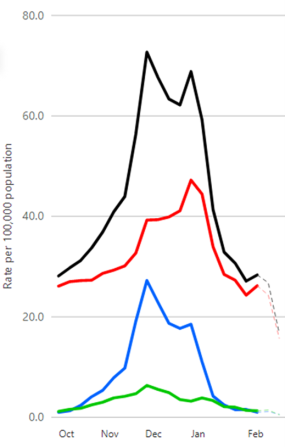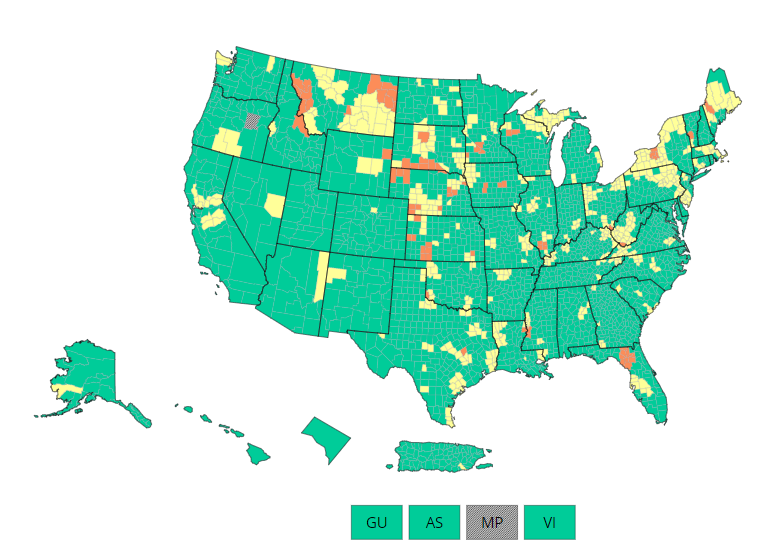Recommendations for Fully Vaccinated People
COVID-19 Homepage
Streamlining COVID-19 Vaccine Recommendations
Interpretive Summary for March 3, 2023
Streamlining COVID-19 Vaccine Recommendations

On February 24, 2023, CDC’s Advisory Committee on Immunization Practices (ACIP) met to discuss the latest COVID-19 vaccine data, as well as potential updates to future COVID-19 vaccination efforts. The discussion included an update on vaccine safety, a risk-benefit assessment of the updated COVID-19 vaccines, and anticipated vaccine updates later this year.
CDC presented new data showing that the updated vaccines protect people against current variants, and the committee expressed support for streamlining and simplifying COVID-19 vaccine recommendations this fall. This includes phasing out the original (monovalent) vaccines and replacing them with the updated (bivalent) vaccines, which protect against the original COVID-19 strain and more recent Omicron subvariants. This change would affect only the people who have not yet received their primary vaccination series, and the U.S. Food & Drug Administration must authorize it before CDC can make a recommendation.
At this point in the pandemic, COVID-19 cases, hospitalizations, and deaths have been decreasing for several weeks, and much of the country has protection against circulating strains either through vaccination, previous infection, or a combination of both. But it’s important to remember that new subvariants continue to emerge—and even if you had COVID-19 before, reinfection is possible and can cause serious illness. We also know that protection from infection-related immunity wanes over time, just like it does from vaccination.
CDC encourages the millions of people in the United States who haven’t gotten a COVID-19 vaccine since the fall, when the updated vaccines were released, to do so now to better protect themselves from severe illness and death. This is particularly true for older adults (50+), people who are immunocompromised or have weakened immune systems, and people with underlying conditions who are at higher risk. Individual situations and COVID-19 vaccine options may be confusing to some. Talk with your healthcare provider for specific information about COVID-19 vaccination related to your situation. Find a vaccine.
Note to Readers: The Disability Information and Access LineExternal can help people with disabilities find local vaccination locations, make appointments, find accessible transportation options, and connect with other community resources to improve access to vaccinations.
Note to Readers: COVID Data Tracker Weekly Review will publish every other week starting March 3. Please visit CDC’s COVID Data Tracker for COVID-19 data, CDC’s Respiratory Virus Hospitalization Surveillance Network (RESP-NET) for data on respiratory virus-associated hospitalizations, and CDC’s National Emergency Department Visits for COVID-19, Influenza, and Respiratory Syncytial Virus dashboard for data on emergency department patient visits with diagnosed COVID-19, influenza, and RSV.
COVID-19 Community Levels*
As of March 2, 2023, there are 77 (2.4%) counties, districts, or territories with a high COVID-19 Community Level, 514 (16.0%) with a medium Community Level, and 2,628 (81.6%) with a low Community Level. Compared with last week, the number of counties, districts, or territories in the high level increased by 0.3%, in the medium level decreased by 4.4%, and in the low level increased by 4.0%. Overall, 45 out of 52 jurisdictions** had high- or medium-level counties this week. Delaware, District of Columbia, Hawaii, Maryland, New Hampshire, Rhode Island, and Utah are the only jurisdictions to have all counties at low Community Levels.
To check your COVID-19 Community Level, visit COVID Data Tracker. To learn which prevention measures are recommended based on your COVID-19 Community Level, visit COVID-19 Community Level and COVID-19 Prevention.
*CDC recommends use of COVID-19 Community Levels to determine the impact of COVID-19 on communities and to take action. CDC also provides Community Transmission Levels to describe the amount of COVID-19 spread within each county. Healthcare facilities use Community Transmission Levels to determine infection control interventions.
**Includes the 50 states, the District of Columbia, and Puerto Rico.
Reported Cases
As of March 1, 2023, the current 7-day average of weekly new cases (32,374) decreased 5.1% compared with the previous 7-day average (34,102). A total of 103,499,382 COVID-19 cases have been reported in the United States as of March 1, 2023.
103,499,382
Total Cases Reported
32,374
Current 7-Day Average*
34,102
Previous 7-Day Average
-5.1%
Change in 7-Day Average since Previous Period
*Historical cases are excluded from weekly new cases and 7-day average calculations until they are incorporated into the dataset for the applicable date. Of 55,875 historical cases reported retroactively, none were reported in the current week and 29,971 in the prior week.
COVID-19 Variants
CDC Nowcast projections* for the week ending March 4, 2023, estimate the proportion of these lineages designated as Omicron with estimates above 1%: XBB.1.5, BQ.1.1, and BQ.1.
XBB.1.5 is projected to be at approximately 89.6% (95% PI 85.6-92.6%).
BQ.1.1 and BQ.1 are projected to be between 1% and 6.7% of circulating lineages.
XBB.1.5 is growing in proportion in all HHS regions. All other virus lineages are predicted to have very slow or no growth in proportion.
See COVID Data Tracker for the proportions of all relevant lineages currently circulating.
*CDC uses Nowcast projections to predict current variant proportions circulating in the United States. The median time from specimen collection to sequence data reporting is about 3 weeks. As a result, weighted estimates for the most recent few weeks may be unstable or unavailable. View Nowcast estimates on CDC’s COVID Data Tracker website on the Variant Proportions page.
Vaccinations
As of March 1, 2023, 672.1 million vaccine doses have been administered in the United States. Overall, about 230.1 million people, or 69.3% of the total U.S. population, have completed a primary series.* About 53.7 million people, or 16.2% of the U.S. population, have received an updated booster dose.
672,076,105
Vaccine Doses Administered
54,086,801
Updated Booster Doses Administered**
230,075,934
People who have completed a primary series* (69.3% of the U.S. population)
53,663,902
People who have received an updated booster (16.2% of the eligible U.S. population)
+0.0
Percentage point change from last week
+0.1
Percentage point change from last week
*Represents the number of people who have received the second dose in a two-dose COVID-19 vaccine series (such as the Pfizer-BioNTech, Moderna, or Novavax vaccines) or one dose of the single-shot Johnson & Johnson’s Janssen vaccine.
**The number of updated booster doses administered is larger than the number of people who have received an updated booster because one person may receive more than one booster dose.
5,999,572
Total New Admissions
3,318
Current 7-Day Average
3,604
Prior 7-Day Average
-7.9%
Change in 7-Day Average
The start of consistent reporting of hospital admissions data was August 1, 2020.
Daily Trends in Number of New COVID-19 Hospital Admissions in the United States
New admissions are pulled from a 10 am EDT snapshot of the HHS Unified Hospital Data – Analytic Dataset. Due to potential reporting delays, data from the most recent 7 days, as noted in the figure above with the grey bar, should be interpreted with caution. Small shifts in historic data may also occur due to changes in the Centers for Medicare & Medicaid Services (CMS) Provider of Services file, which is used to identify the cohort of included hospitals.
RESP-NET: COVID-19 Trends in Hospitalizations Among Adults Ages 65 Years and Older
CDC’s Respiratory Virus Hospitalization Surveillance Network (RESP-NET) shows that overall weekly rates of COVID-19-associated hospitalizations among adults ages 65 years and older remain elevated, at 26.1 per 100,000 population for the week ending February 11, 2023.
Weekly Rates of Respiratory Virus-Associated Hospitalizations Among Adults 65 Years and Older


The dashed lines for the current season indicate potential reporting delays and interpretation of trends should exclude data from recent weeks. Coronavirus Disease 2019 (COVID-19)-Associated Hospitalization Surveillance Network (COVID-NET), a RESP-NET platform, is an additional source for hospitalization data collected through a network of more than 250 acute-care hospitals in 13 states (representing ~10% of the U.S. population). Detailed data on patient demographics, including race and ethnicity, underlying medical conditions, medical interventions, and clinical outcomes, are collected using a standardized case reporting form.
Deaths
The current 7-day average of new deaths (327) decreased 3.3% compared with the previous 7-day average (338). As of March 1, 2023, a total of 1,117,856 COVID-19 deaths have been reported in the United States.
1,117,856
Total Deaths Reported
327
Current 7-Day Average*
338
Prior 7-Day Average
-3.3%
Change in 7-Day Average Since Prior Period
*Historical deaths are excluded from the weekly new deaths and 7-day average calculations until they are incorporated into the dataset by their applicable date. Of 4,113 historical deaths reported retroactively, none were reported in the current week and none were reported in the prior week.
Testing
The percentage of COVID-19 NAATs (nucleic acid amplification tests)* that are positive is decreasing in comparison to the previous week. The 7-day average of percent positivity from NAATs is now 8.8%. The 7-day average number of tests reported for February 17–23, 2023, was 209,952, down 21.1% from 266,005 for the prior 7 days.
1,020,487,677
Total Tests Reported
209,952
7-Day Average Tests Reported
8.8%
7-Day Average % Positivity
9.6%
Previous 7-Day Average % Positivity
-0.81
Percentage point change in 7-Day Average % Positivity since Prior Week
*Test for SARS-CoV-2, the virus that causes COVID-19
Wastewater Surveillance
COVID Data Tracker’s Wastewater Surveillance tab tracks levels, changes, and detections of SARS-CoV-2* viral RNA in wastewater at over 1,200 testing sites across the country.
Currently, about 62% of sites across the country are reporting moderate to high SARS-CoV-2 levels in wastewater. About 27% of sites reporting wastewater data are currently seeing some of the highest levels for those sites since December 1, 2021. About 49% of sites are experiencing a decrease in SARS-CoV-2 levels, and about 40% are reporting an increase.
For more information on how to use wastewater data, visit CDC’s wastewater surveillance website.
*The virus that causes COVID-19
SARS-CoV-2 Levels in Wastewater by Site

0% denotes that levels are the lowest they have been at the site; 100% denotes that levels are the highest they have been at the site.




